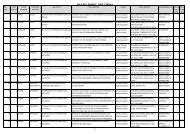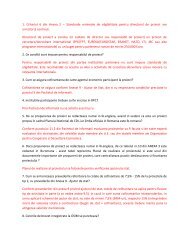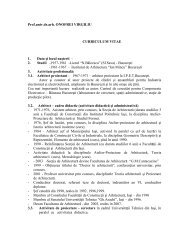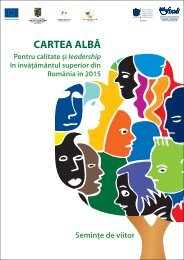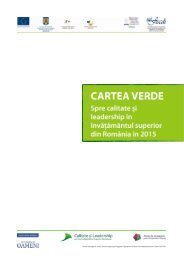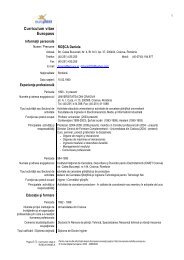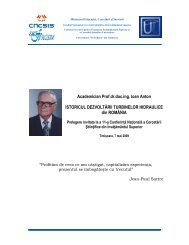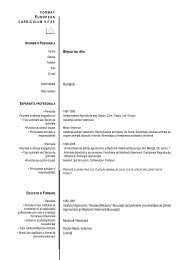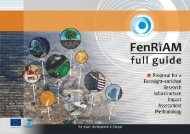Managementul activitatilor tertiare - uefiscdi
Managementul activitatilor tertiare - uefiscdi
Managementul activitatilor tertiare - uefiscdi
Create successful ePaper yourself
Turn your PDF publications into a flip-book with our unique Google optimized e-Paper software.
CapabilitiesExploitationConceptual framework for analysing Third Stream activitiesAssociated Third Stream activitiesTechnology commercialization(a)KnowledgEntrepreneurial activitiesAdvisory work and contracts(b) FacilitiesCommercialization of facilitieslarge publicly funded research projects designed to lure researchers away from more traditionalbases in Europe and America.Other UK universities that are less well-known for their research and that have been moreteaching-focussed also want to get involved in third stream activities as a way of boosting theirresearch reputations. With traditional external funding, such as that from funding councils, sodifficult to acquire, it is possible to use third stream activities to bring in extra cash.External Resource: Russel Group Report in 2002Contract research(c) ResearchCollaboration in academic researchStaff flowActivities(d) Teaching(e) CommunicationStudent placements…Learning activitiesCurriculum alignmentSocial networkingNon-academic disseminationStudy case – the Russell Group in UKThe more prestigious Russell Group universities http://www.russellgroup.ac.uk/ (those institutionswho are leading the way in research activities already) are very keen to maximise their thirdstream projects and build on their already excellent research reputations. The twenty institutionsin the group already attract two-thirds of the country's external research funding so they are in agood position to move into third-stream activities. Russell Group institutions want to continue toattract world-class researchers so that they might continue to enhance their reputation: thisrelationship works in a cyclical manner.So, attracting the best people is a key challenge for these universities. They see their competitionas coming mostly from the United States where different funding regimes, especially huge collegeendowments, allow certain institutions to undertake the expansion of research and teachingprogrammes. But also developing countries like China and India are entering into the market with1415The 3 rd stream activities Funding ManagementFunding miningLong and short-term financingHow to attract, maintain and use funds including the industry (FP7 calls regional impact funding,structural funding, POR, FS)Contract or sponsored research fundingEntrepreneurial and commercial income (‘contract’, ‘sales of services’ or ‘other income’)Philanthropic funding (‘donations and gifts’)Internal financing (‘interest/dividends’ and ‘income from investments’)Other private incomeThe impact and benefit of different funds for community (study cases)Funding categoriesHigher education is considered to be a public good. Hence, funding the institutions of highereducation adequately is considered a public responsibility. Not surprisingly then, at this momentthe major part of the financial resources of the higher education institutions is provided by thegovernment.The problem of higher education funding in its simplest form is as follows: If first stream incomefrom state subsidies, and second stream income from tuition no longer suffice to keep a universitygoing, the question about what to do becomes pressing. A drop in government subsidies to publicuniversities and other institutions of higher learning is a worldwide trend.“The global higher education environment is very dynamic, mirroring the fluidity of globalsocio-economic and political interactions. There can be no denying that significant changesand shifts are in process and that these will, to large extent, be driven by demand and notso much by policy. This is particularly relevant in the light of the increasingcommodification of knowledge, the increasing eminence of technology, reduced16government subsidies, and an increasing dependence on partnerships and collaboration. Itis therefore incumbent upon us to find means of offsetting the reductions in resources,funding and subsidy by generating an additional third stream income that will supplementthe more traditional income from first and second stream.”Barney pityana (VC, UNISA)http://www.inyathelo.co.za/media/docs/124213758012.pdfThird stream income can be defined as follows: “all income derived from sources other than publicsubsidies (“first stream income”) and tuition and other student fees (“second stream income”).Third stream income typically comprises:• Contract or sponsored research funding (“contract income’)• Entrepreneurial and commercial income (“contract”, “sales of services”, “renting” or“other income”)• Finantari din programe europene (FP7, fonduri structurale, etc) sau internationale (dinafara Europei)• Philanthropic funding (“donations and gifts”)• Internal financing (“interest/dividends” and “income from investements”)• Long- and short-term financing• Other private income (“other income”)Contract or sponsored research fundingThe following reasons motivate the research partnerships with industry:• Disseminating emerging knowledge to the private sector• Testing concepts and face challenges in the “real world”• Benefiting from specialized industry knowledge and facilities• Encouraging partnerships that promote student learning and employment opportunities• Creating new jobs in changing economy.• Supplementing and enabling federal research support• Generating political support and philanthropyThere are clear benefits to embarking on a tech transfer initiative. For example, these initiativeswill enhance the likelihood that new discoveries and innovations will lead to useful products,processes and services to benefit the general public. In particular, tech transfer:17



